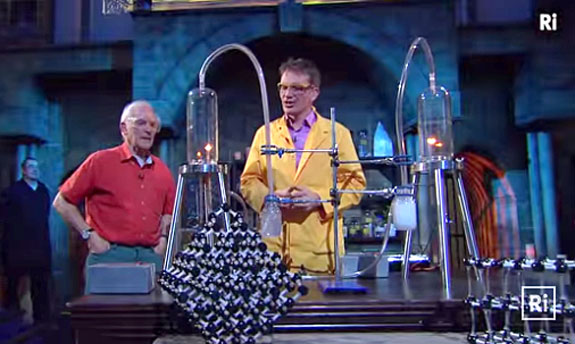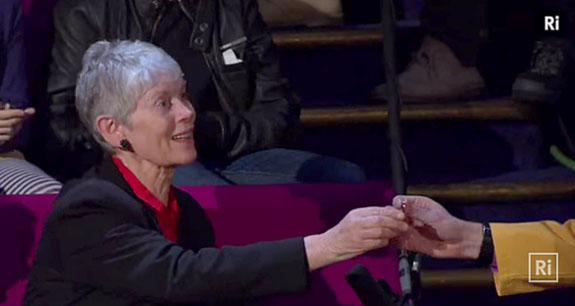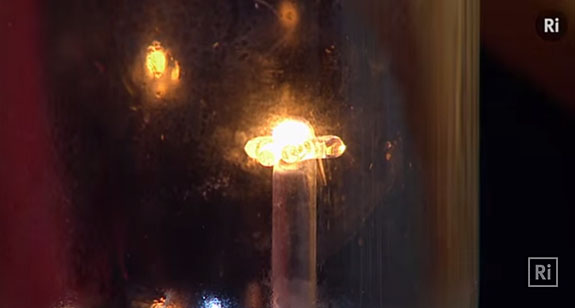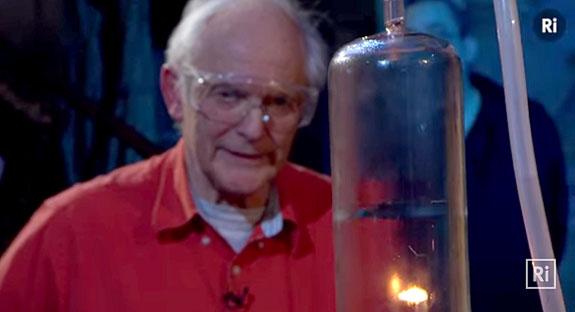May 19th, 2015
Sitting on its lofty perch atop the Mohs scale, diamond is the hardest naturally occurring material known to man. It is harder than a ruby, sapphire or emerald and has the ability to slice through steel like a hot knife through butter. The only substance that can scratch a diamond is another diamond.

Under normal circumstances, diamonds truly are forever. But in the labs of the British Royal Institution, the famous De Beers ad slogan — not to mention the theme of the Shirley Bassey hit song — has been put to the test.
Because a diamond is made of pure carbon, scientists have theorized since the 1700s that a diamond should burn like other carbon materials, such as graphite or coal.
And, indeed, during the early 1770s, French chemist Antoine Lavoisier used two powerful lenses to magnify the sun’s rays directly onto a diamond. The diamond slowly disappeared and carbon dioxide gas accumulated, proving that the diamond was made from carbon.
In the video below, British scientist and author Peter Wothers enlists the help of Nobel prize-winning chemist Sir Harry Kroto to demonstrate what it takes to get a diamond to burn.

Wothers adds a bit of drama and comic relief by using Kroto’s wife’s engagement diamond for the experiment. The viewer can see Kroto getting increasingly more uncomfortable as it becomes very clear that his wife’s diamond — under the right conditions — will ignite.

In pure oxygen, diamonds can ignite at 1320 degrees F. In normal conditions, the ignition occurs at about 1520 degrees F.
Wother’s experiment is conducted in a chamber of pure oxygen. The resulting gases are collected in a tube leading to a beaker of limewater. The experiment anticipates that if the burning material contains carbon, the smoke will contain carbon dioxide. When the carbon dioxide mixes into the limewater, it turns the mixture a milky white color — basically delivering calcium carbonate, an antacid used to calm a sour stomach.

Wother’s does his first experiment using a bit of graphite, which he easily ignites using a torch. Then he ups the ante by doing the exact same experiment using the Kroto engagement diamond.

Surprisingly, that lights up, too. The diamond burns as a golden ember without producing any flames. At this point, Kroto half-jokingly comments that he hopes the show can pay for a replacement diamond.
As you might have figured out by now, Wother had cleverly swapped the Krotos’ engagement diamond with a much lower quality specimen before the experiment began.
If you’re worried about how a diamond is protected when a ring needs to be retipped, for example, be assured that jewelers go to great lengths to make sure that the extreme heat of the torch does not affect the gemstone. Some jewelers use boron to protect the stone while others depend on the pinpoint accuracy of a laser welder to keep the diamond out of harm’s way.
Kroto won his Nobel Prize in Chemistry in 1996 for his work in discovering fullerenes, a pure carbon molecule that takes a shape similar to a soccer ball. Recent research has suggested many uses for fullerenes, including medical applications, superconductors, fiber-optics systems and nanotechnology.
Check out Wother’s diamond-burning experiment here…
Images: YouTube screen captures.

Under normal circumstances, diamonds truly are forever. But in the labs of the British Royal Institution, the famous De Beers ad slogan — not to mention the theme of the Shirley Bassey hit song — has been put to the test.
Because a diamond is made of pure carbon, scientists have theorized since the 1700s that a diamond should burn like other carbon materials, such as graphite or coal.
And, indeed, during the early 1770s, French chemist Antoine Lavoisier used two powerful lenses to magnify the sun’s rays directly onto a diamond. The diamond slowly disappeared and carbon dioxide gas accumulated, proving that the diamond was made from carbon.
In the video below, British scientist and author Peter Wothers enlists the help of Nobel prize-winning chemist Sir Harry Kroto to demonstrate what it takes to get a diamond to burn.

Wothers adds a bit of drama and comic relief by using Kroto’s wife’s engagement diamond for the experiment. The viewer can see Kroto getting increasingly more uncomfortable as it becomes very clear that his wife’s diamond — under the right conditions — will ignite.

In pure oxygen, diamonds can ignite at 1320 degrees F. In normal conditions, the ignition occurs at about 1520 degrees F.
Wother’s experiment is conducted in a chamber of pure oxygen. The resulting gases are collected in a tube leading to a beaker of limewater. The experiment anticipates that if the burning material contains carbon, the smoke will contain carbon dioxide. When the carbon dioxide mixes into the limewater, it turns the mixture a milky white color — basically delivering calcium carbonate, an antacid used to calm a sour stomach.

Wother’s does his first experiment using a bit of graphite, which he easily ignites using a torch. Then he ups the ante by doing the exact same experiment using the Kroto engagement diamond.

Surprisingly, that lights up, too. The diamond burns as a golden ember without producing any flames. At this point, Kroto half-jokingly comments that he hopes the show can pay for a replacement diamond.
As you might have figured out by now, Wother had cleverly swapped the Krotos’ engagement diamond with a much lower quality specimen before the experiment began.
If you’re worried about how a diamond is protected when a ring needs to be retipped, for example, be assured that jewelers go to great lengths to make sure that the extreme heat of the torch does not affect the gemstone. Some jewelers use boron to protect the stone while others depend on the pinpoint accuracy of a laser welder to keep the diamond out of harm’s way.
Kroto won his Nobel Prize in Chemistry in 1996 for his work in discovering fullerenes, a pure carbon molecule that takes a shape similar to a soccer ball. Recent research has suggested many uses for fullerenes, including medical applications, superconductors, fiber-optics systems and nanotechnology.
Check out Wother’s diamond-burning experiment here…
Images: YouTube screen captures.


